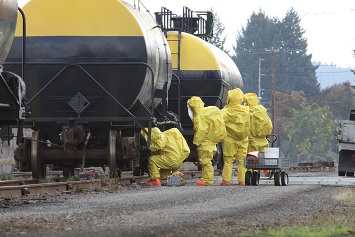Q: What pre-medical test should be done for DOT shippers, warehouse people, field inspectors, archaeologists, oil spill clean up crew (i.e. those with a chance of encountering and/or cleaning up hazardous waste)?

A: The U.S. Department of Labor’s Occupational Safety and Health Administration (OSHA) developed workplace health and safety standards to protect employees engaged in hazardous waste operations and emergency response activities (the Hazardous Waste Operations and Emergency Response (HAZWOPER) standard). The HAZWOPER rules require employers to develop and implement a written safety and health program for their employees involved in hazardous waste operations. While the HAZWOPER rules specify that the definition of “employers” “does not include the United States” (for example, any federal department or agency such as The Department of Transportation), most federal departments and agencies either choose to follow the HAZWOPER rules as a policy, or have been required to follow them pursuant to an Executive Order. Regardless of whether your federal department is excluded, it is a best management practice to follow the HAZWOPER standards.
Affected employees. The HAZWOPER safety and health program must include numerous elements, as specified in 29 CFR 1910.120(b). Among them is the medical surveillance component that includes the requirements of 29 CFR 1910.120(f). The medical surveillance program applies to the following four groups of employees:
- All employees who are or may be exposed to hazardous substances or health hazards at or above the permissible exposure limits or, if there is no permissible exposure limit, above the published exposure levels for these substances, without regard to the use of respirators, for 30 days or more a year;
- All employees who wear a respirator for 30 days or more a year or as required by 29 CFR 1910.134;
- Members of HAZMAT teams; and
- All employees who are injured, become ill or develop signs or symptoms due to possible overexposure involving hazardous substances or health hazards from an emergency response or hazardous waste operation.

Frequency of medical exams. Medical examinations and consultation must be made available to each employee in the first three groups at these times:
- Prior to assignment;
- At least once every 12 months unless the attending physician believes a longer interval (not greater than biennially) is appropriate,
- At termination of employment or reassignment to an area where the employee would not be covered if the employee has not had an examination within the last 6 months;
- As soon as possible upon notification by an employee that the employee has developed signs or symptoms indicating possible overexposure to hazardous substances or health hazards, or that the employee has been injured or exposed above the permissible exposure limits or published exposure levels in an emergency situation; and
- At more frequent times, if the examining physician determines that an increased frequency of examination is medically necessary.
For employees in the fourth group (i.e. injured or ill employees) and all employees including those who may have been injured, received a health impairment, developed signs or symptoms which may have resulted from exposure to hazardous substances resulting from an emergency incident, or exposed during an emergency incident to hazardous substances at concentrations above the permissible exposure limits or the published exposure levels without the necessary personal protective equipment being used, the frequency is:
- As soon as possible following the emergency incident or development of signs or symptoms; and
- At additional times, if the examining physician determines that follow-up examinations or consultations are medically necessary.
